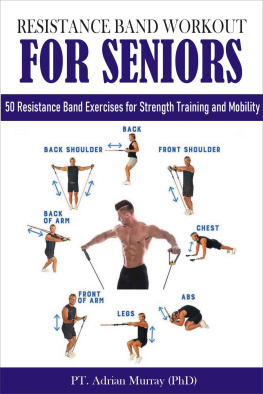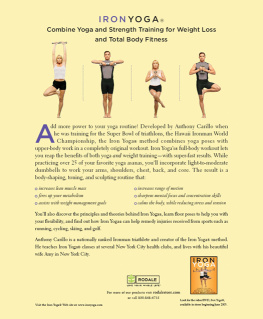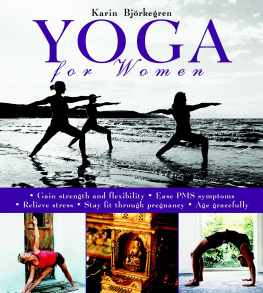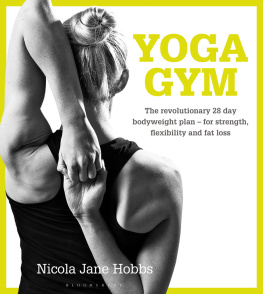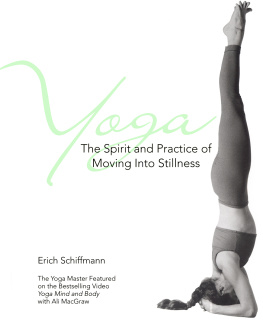

for my slum goddess of the Lower East Side
Weight-Resistance
YOGA

Very impressive and necessary. Im excited by this unique blend of Western-style strength training combined with the flexibility and meditative side of yoga. Popovs book is for all of us. It offers functional movement along with serentiy and mindfulness.
COLLEEN CRAIG, AUTHOR OFPILATES ON THE BALL, ABS ON THE BALL, AND STRENGTH TRAINING ON THE BALL
Melding hatha yoga and weight training into a blended practice, Max Popov shows us how these disciplines are not only completely compatible but also how each brilliantly supports the others path of inquiry. By combining both, we go far beyond the individual benefits of stretching or strength and enter directly into the domain of a powerfully embodied spirituality.
WILL JOHNSON, AUTHOR OFYOGA OF THE MAHAMUDRA
Bringing the yogic principle of mindfulness into all aspects of our lives is one of the ultimate goals of yoga. I recommend this book for anyone wishing to bring more spiritual depth to any physical exercise program.
BIFF MITHOEFER, AUTHOR OF THE YIN YOGA KITAND COAUTHOR OF THE THERAPEUTIC YOGA KIT
ACKNOWLEDGMENTS
To my once and forever yoga teacher Judy Brick Freedman, who initiated me on my yoga journey; to the seer Will Johnson, who put in a good word for me at Inner Traditions; to my godsend, my Inner Traditions project editor, Laura Schlivek, who shepherded my book to publication; to my illustrators, Jacque Auger, Sarah Knotz, Henry Wojtas, and Vince Serecin, who created beautiful artthank you all for putting up with me!
PREFACE
MY JOURNEY TO WEIGHT-RESISTANCE YOGA
In 1922, twenty-four-year-old Kolar Venkatesha Iyer founded the Hercules Gymnasium in Bangalore. It was the first commercial enterprise in India for bodybuilding, popularized in the West in the 1890s by Eugen Sandow, the German showman who originated flaunting ones muscular physique instead of showing off ones strength prowess. Iyer housed his gymnasium in what was once Tipu Sultans summer palacean ornate, two-storied, Indo-Islamic structure made of wood. Located in the rear of the state-owned building, the gymnasium consisted of two small rooms accessed by going around to the back and entering directly from the outside. At first there were only four students.
K. V. Iyer bestowed upon his students not only a muscular, harmonious physiqueachieved through bell exercises and muscle controlbut also the capacity to ward off chronic disease by virtue of the therapeutic practices of hatha yoga: asana (postures), kriya (cleansing techniques), mudra (seals), and bandha (locks). In so doing, he became the first person to combine what he called the Cult of Body-building and the Hata-yoga Cult. My aim in My System, he proclaimed in 1930, is to reconcile these two great systems to assure the future Culturist of robustness of health and beauty of limb and trunk.
By the late 1930s, Iyer, who had become Indias most famous bodybuilder and the owner of Indias largest and most successful gymnasium, came to realize that the principal benefit of weight-resistance training isnt its ability to develop large muscles, with the attendant pitfall of over-strain,
An Indian enthralled with the muscle-building systems of Europeans, yet proud of and indebted to the indigenous Indian practice of hatha yoga, Iyer had forged a dynamic system in which movements resisting opposing forces were coupled with movements surrendering to opposing forcesa combination that provided fitness and good health. About fifty years later, I unknowingly replicated his system when I began practicing and teaching a regimen that combined Western strengthening and yogic stretching exercises.
I first learned about Iyer in 1994 in David L. Chapmans biography of Sandow.
Although I attended my first hatha yoga class in a bare loft located on Broadway in midtown Manhattan in the late 1960s, I only became immersed in hatha yoga in 1986 when I began taking classes with a dour, inspiring teacher at the first Iyengar Yoga Center of New York in Soho. Iyengar yoga demands unprecedented precision and lan, with careful attention paid to strict spinal alignment, using blocks, belts, and blankets to make accommodations. Marked equally by the finickiness and flamboyance of its founder, Iyengar yoga is a vigorous form of asana practice.
Several months after my immersion in Iyengar yoga, I took up strength training at a small, storefront gym, Natural Physique Centre, in the East Village. A skinny, withdrawn guy, I found myself among beefy men, with bald chests, and women, in skimpy spandex outfits, dedicated to pumping iron. What could be less like yoga than the glorification of aggressive muscular display (by mostly affable men and women) that I saw around me? Yet, what immediately struck me was that strength trainingthe stripped-down version of bodybuildingand yogic flexibility training are inherently similar. Both exercise regimens seek to attain and maintain muscle and joint fitness. Both require a vast degree of resolve in order to expend great physical effort and overcome discomfort and fatigue.
In fact, I realized, the basic differences in fitness (the ability to perform muscle and joint work satisfactorily) between weight-resistance training (contracting muscles to increase strength) and yogic weight-surrender training (elongating muscles to increase flexibility) are complementary: together they make a whole and complete fitness regimen. They seem incompatible only because of the way weight-resistance training is commonly performedsomething, I knew, that could be changed.
What I saw around me in the gym were weight-resistance exercises performed with sloppy formmovements that were careless, rushed, and spasmodic. To avoid this way of performing, I simply applied to my strengthening exercises the principles that I learned in yoga class: using moderately slow, controlled movements, maintaining postural alignment as much as possible, concentrating on moving a part of the body while expanding attention to the entire body, and breathing rhythmically. With the result that I established a weight-resistance routinewhat I started thinking of as a weight-resistant yoga practicethat not only was efficient, safe, and effective but also, I discovered, facilitated mindfulness.
Mindfulness involves a directed (not just a vague) awareness of what were doing. Knowing that left untended, the mind, like a neglected child, becomes unruly, yogins seek to empty the mind of all thoughts that are impediments to full concentration. We notice when our mind wanders to nagging or fleeting thoughtssuch as regret over a flare-up of anger, or anxiety over meeting a deadline, or the desire for a painful exercise to be over. Then we bring our attention back to the minute demands of the task at hand and in so doing cultivate calmness and contentment.
These exercise principles taken from my yogic stretching practice, as well as the principles inherent in my strengthening practice, make up the exercise guidelines in part one of this book. They will enable you to perform the strengthening exercises, in part two, as mindful hatha yoga.
In the late 1980s, my weight-resistance yoga practice gradually turned meditative. The meditations werent traditional. The subject wasnt fire or Vishnu or some other god (whom I imagined being in the lotus of the heart). Nor were the meditations New Age guided imagery. The subject wasnt a placid picture of me sitting in a flower garden or some such idyllic scene. The meditations were evoked by the movements of my body against resistance. I found myself comprehending realities behind everyday life through performing such exercises as bending backward on the Roman chair (sensing the poignancy of my mortality in my spinal bones); lifting a weight off my shoulders (bringing awareness to how all activities involve resisting and surrendering to the wearying pull of gravity); or toe raises (realizing that the restless quest for novelty can be replaced with the satisfactions of pleasurable repetition)in other words, through becoming absorbed in my embodied being. I had no context for these experiences. Until I read B. K. S. Iyengars
Next page


